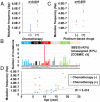A quantification method of somatic mutations in normal tissues and their accumulation in pediatric patients with chemotherapy
- PMID: 35895679
- PMCID: PMC9351471
- DOI: 10.1073/pnas.2123241119
A quantification method of somatic mutations in normal tissues and their accumulation in pediatric patients with chemotherapy
Abstract
Somatic mutations are accumulated in normal human tissues with aging and exposure to carcinogens. If we can accurately count any passenger mutations in any single DNA molecule, since their quantity is much larger than driver mutations, we can sensitively detect mutation accumulation in polyclonal normal tissues. Duplex sequencing, which tags both DNA strands in one DNA molecule, enables accurate count of such mutations, but requires a very large number of sequencing reads for each single sample of human-genome size. Here, we reduced the genome size to 1/90 using the BamHI restriction enzyme and established a cost-effective pipeline. The enzymatically cleaved and optimal sequencing (EcoSeq) method was able to count somatic mutations in a single DNA molecule with a sensitivity of as low as 3 × 10-8 per base pair (bp), as assessed by measuring artificially prepared mutations. Taking advantages of EcoSeq, we analyzed normal peripheral blood cells of pediatric sarcoma patients who received chemotherapy (n = 10) and those who did not (n = 10). The former had a mutation frequency of 31.2 ± 13.4 × 10-8 per base pair while the latter had 9.0 ± 4.5 × 10-8 per base pair (P < 0.001). The increase in mutation frequency was confirmed by analysis of the same patients before and after chemotherapy, and increased mutation frequencies persisted 46 to 64 mo after chemotherapy, indicating that the mutation accumulation constitutes a risk of secondary leukemia. EcoSeq has the potential to reveal accumulation of somatic mutations and exposure to environmental factors in any DNA samples and will contribute to cancer risk estimation.
Keywords: chemotherapy; duplex sequencing; next-generation sequencing; normal tissue; somatic mutation.
Conflict of interest statement
The authors declare no competing interest.
Figures





Similar articles
-
Next-generation sequencing methodologies to detect low-frequency mutations: "Catch me if you can".Mutat Res Rev Mutat Res. 2023 Jul-Dec;792:108471. doi: 10.1016/j.mrrev.2023.108471. Epub 2023 Sep 15. Mutat Res Rev Mutat Res. 2023. PMID: 37716438 Free PMC article. Review.
-
A novel method to quantify base substitution mutations at the 10-6 per bp level in DNA samples.Cancer Lett. 2017 Sep 10;403:152-158. doi: 10.1016/j.canlet.2017.06.010. Epub 2017 Jun 19. Cancer Lett. 2017. PMID: 28642169
-
Somatic mutation landscapes at single-molecule resolution.Nature. 2021 May;593(7859):405-410. doi: 10.1038/s41586-021-03477-4. Epub 2021 Apr 28. Nature. 2021. PMID: 33911282
-
Direct quantification of in vivo mutagenesis and carcinogenesis using duplex sequencing.Proc Natl Acad Sci U S A. 2020 Dec 29;117(52):33414-33425. doi: 10.1073/pnas.2013724117. Epub 2020 Dec 14. Proc Natl Acad Sci U S A. 2020. PMID: 33318186 Free PMC article.
-
Direct mutation analysis by high-throughput sequencing: from germline to low-abundant, somatic variants.Mutat Res. 2012 Jan 3;729(1-2):1-15. doi: 10.1016/j.mrfmmm.2011.10.001. Epub 2011 Oct 12. Mutat Res. 2012. PMID: 22016070 Free PMC article. Review.
Cited by
-
Next-generation sequencing methodologies to detect low-frequency mutations: "Catch me if you can".Mutat Res Rev Mutat Res. 2023 Jul-Dec;792:108471. doi: 10.1016/j.mrrev.2023.108471. Epub 2023 Sep 15. Mutat Res Rev Mutat Res. 2023. PMID: 37716438 Free PMC article. Review.
-
Frequency and spectrum of mutations in human sperm measured using duplex sequencing correlate with trio-based de novo mutation analyses.Sci Rep. 2024 Oct 8;14(1):23134. doi: 10.1038/s41598-024-73587-2. Sci Rep. 2024. PMID: 39379474 Free PMC article.
-
Chemotherapy and the somatic mutation burden of sperm.JCI Insight. 2025 May 13;10(12):e188175. doi: 10.1172/jci.insight.188175. eCollection 2025 Jun 23. JCI Insight. 2025. PMID: 40359030 Free PMC article.
-
Effect of sequencing platforms on the sensitivity of chemical mutation detection using Hawk-Seq™.Genes Environ. 2024 Oct 9;46(1):20. doi: 10.1186/s41021-024-00313-9. Genes Environ. 2024. PMID: 39385252 Free PMC article.
-
Detection of rare mutations, copy number alterations, and methylation in the same template DNA molecules.Proc Natl Acad Sci U S A. 2023 Apr 11;120(15):e2220704120. doi: 10.1073/pnas.2220704120. Epub 2023 Apr 4. Proc Natl Acad Sci U S A. 2023. PMID: 37014860 Free PMC article.
References
-
- Ushijima T., Clark S. J., Tan P., Mapping genomic and epigenomic evolution in cancer ecosystems. Science 373, 1474–1479 (2021). - PubMed
Publication types
MeSH terms
LinkOut - more resources
Full Text Sources

